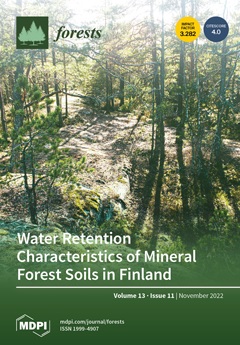View Item
- xmlui.general.dspace_homeCentros Regionales y EEAsCentro Regional Patagonia SurEEA Santa CruzArtículos científicosxmlui.ArtifactBrowser.ItemViewer.trail
- DSpace Home
- Centros Regionales y EEAs
- Centro Regional Patagonia Sur
- EEA Santa Cruz
- Artículos científicos
- View Item
Composition and Spatial Variation of Germinable Seed Bank in Burned Nothofagus pumilio Forests in Patagonia Argentina
Abstract
The availability of soil-stored seed determines initial plant functional types in post-fire landscapes. We evaluated the post-fire regeneration of Nothofagus pumilio forests, in Patagonia, Argentina, analyzing the soil seed bank (SSB) and the above-ground vegetation (AV). At three sites: La Colisión, Río Turbio and Monte Zeballos, burned in 2008, 1980 and 1941, respectively, we sampled the SSB and AV in two transects from the edge of the remaining forest,
[ver mas...]
The availability of soil-stored seed determines initial plant functional types in post-fire landscapes. We evaluated the post-fire regeneration of Nothofagus pumilio forests, in Patagonia, Argentina, analyzing the soil seed bank (SSB) and the above-ground vegetation (AV). At three sites: La Colisión, Río Turbio and Monte Zeballos, burned in 2008, 1980 and 1941, respectively, we sampled the SSB and AV in two transects from the edge of the remaining forest, up to 90 m within the burned area, and recorded the emergence (198 soil samples) and presence of vascular species. To determine the effect of the distance to the remnant forest on the germinable seed bank, we performed simple linear regression analysis through the use of linear mixed-effect models, and we analyzed the similarity between the composition of SSB and AV with PERMANOVA. The emergence of plant growth forms had different patterns in relation to the distance from the forest in the three sites, which might be associated with the time of fire occurrence, and specific characteristics of each site. The emergence of N. pumilio was registered at more than one distance at the recent burning site. Herbs constituted the main source of cover with 69% of the composition, and native/endemic species represented 71%. This study contributes to the understanding of the relationship between the seed bank and standing vegetation and a better understanding of the resilience of post-fire N. pumilio forests. Our findings suggest that from 15–20 m from the edge, the SSB would be insufficient to ensure the spontaneous recovery of the forest, making active restoration necessary in order to tend to a recovery of the structure and functionality of the original community.
[Cerrar]

Author
Urretavizcaya, María Florencia;
Albarracín, Viviana;
Orellana Ibáñez, Ivonne Alejandra;
Rago, M. Melisa;
Lopez Bernal, Pablo;
Monelos, Lucas H.;
Peri, Pablo Luis;
Fuente
Forests 13 (11) : 1902. (November 2022)
Date
2022-11-12
Editorial
MDPI
ISSN
1999-4907
Formato
pdf
Tipo de documento
artículo
Palabras Claves
Derechos de acceso
Abierto
 Excepto donde se diga explicitamente, este item se publica bajo la siguiente descripción: Creative Commons Attribution-NonCommercial-ShareAlike 2.5 Unported (CC BY-NC-SA 2.5)
Excepto donde se diga explicitamente, este item se publica bajo la siguiente descripción: Creative Commons Attribution-NonCommercial-ShareAlike 2.5 Unported (CC BY-NC-SA 2.5)


